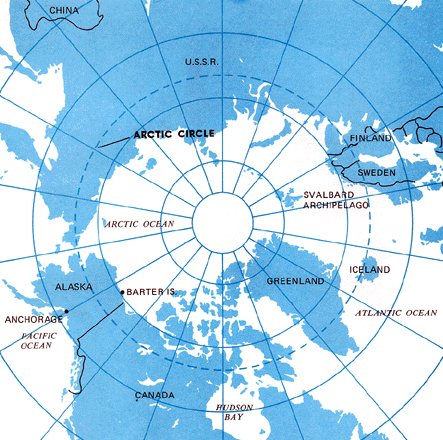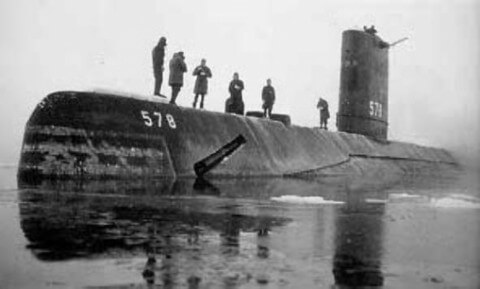Post by marchesarosa on Dec 4, 2009 14:13:14 GMT
Headline from
The Washington Post
November 2nd, 1922.
Arctic Ocean Getting Warm; Seals Vanish and Icebergs Melt.
(The newspaper article was located in the Library of Congress archives by James Lockwood.)
I have taken the trouble to type out the archive report which was the basis for the above headline because it is so interesting in view of the present hysteria concerning contemporary arctic sea ice melt
The Arctic seems to be warming up. Reports from fishermen, seal hunters, and explorers who sail the seas about Spitzbergen and the eastern Arctic, all point to a radical change in climatic conditions, and hitherto unheard of high temperatures in that part of the earth’s surface.
In August, 1922, the Norwegian Department of Commerce sent an expedition to Spitzbergen and Bear island under the leadership of Dr Adolf Hoel, lecturer on geology at the University of Christiana. Its purpose was to survey and chart the lands adjacent to the Norwegian mines on those islands, take soundings of the adjacent waters, and make other oceanographic investigations.
Dr Hoel, who has just returned, reports the location of hitherto unknown coal dposits on the eastern shors of Advent Bay - deposits of vast extent and superior quality. This is regarded as of first importance, as so far most of the coal mined by the Norwegian companies on those islands has not been of the best quality.
The oceanographic observations have, however, been even more interesting. Ice conditions were exceptional. In fact, so little ice has never before been noted. The expedition all but established a record, saling as far north as 81 degrees 29 minutes in ice-free water. This is the farthest north ever reached with modern oceanographic apparatus.
The character of the waters of the great polar basin has heretofor been practically unknown. Dr Hoel reports that he made a section of the Gulf Stream at 81 degrees north latitude and took soundings to a depth of 3,100 meters. These show the Gulf Stream very warm, and it could be traced as a surface current till beyond the 81st parallel. The warmth of the waters makes it probable that the favorable ice conditions will continue for some time.
Later a section was taken of the Gulf Stream off Bear Island and off the Isfjord, as well as a section of the cold current that comes down along the west coast of Spitbergen off the south cape.
In connection with Dr Hoel’s report, it is of interest to note the unusually warm summer in Arctic Norway and the observations of Capt. Martin Ingebrigtsen, who has sailed the eastern Arctic for 54 years past. He says that he first noted warmer conditions in 1918, that since that time it has steadily gotten warmer, and that today the Arctic of that region is not recognizable as the same Arctic region of 1868 to 1917.
Many old landmarks are so changed as to be unrecognizable. Where formerly great masses of ice were found, there are now often morraines, accumulations of earth and stones. At many points where glaciers formerly extended far into the sea they have entirely disappeared.
The change in the temperature, says Capt. Ingebrigtsen, has also brought about great change in the flora and fauna of the Arctic. This summer he sought for white fish in Spitsbergen waters. Formerly great shoals of them were found here. This year he saw none, although he visited all the old fishing grounds.
There were few seal in Spitzbergen waters this year, the catch being far under the average. This, however, did not surprise the captain. He pointed out that formerly the waters about Spitzbergen held an even summer temperature of about 3 degrees Celsius; this year recorded temperatures of about 15 dgrees Celsius, and last year the ocean did not freeze over even on the north coast of Spitzbergen.
With the disappearance of white fish and seal has come other life in these waters. This year herring in great shoals were found along the west coast of Spitzbergen, all the way from the fry to the veritable great herring. Shoals of smelt were also met with.
ooooo
Isn’t the internet wonderful - giving people like me access to this fabulous historical archive? It is like going back in time. What a privilege to retype this old story here for modern readers to appreciate. I hope you do appreciate it and draw the appropriate conclusions from it.
NB This warming, which was also experienced in Greenland, lasted from 1918 to C1939.
wattsupwiththat.files.wordpress.com/2008/03/changing-artic_monthly_wx_review.png

Map of the Arctic Ocean, perhaps more accurately described as the "Great Polar Basin" in the above report. Also shows the lines of latitude. Spitzbergen is described as the Svalbard Archipelago these days.
Being almost landlocked, the Arctic Ocean is a rather special case, as oceans go, I guess.
An anecdote I recently heard about Svalbard. There are more polar bears (2000) there than humans and you can carry a gun to protect yourself from them. So much for the endangered species.
"Firearms for protection against polar bears
Firearm permits for protection against polar bears may be issued to persons that fulfil the general applicant requirements. Permits are normally issued for rifles of calibre .308W/30-06 or 12-gauge shotguns or corresponding. Single-hand firearm permits are generally not issued for protection against polar bears.
Permits are conditional: Valid only for protection against polar bears on Svalbard."
www.sysselmannen.no/hovedEnkel.aspx?m=58146&amid=2828912
The Washington Post
November 2nd, 1922.
Arctic Ocean Getting Warm; Seals Vanish and Icebergs Melt.
(The newspaper article was located in the Library of Congress archives by James Lockwood.)
I have taken the trouble to type out the archive report which was the basis for the above headline because it is so interesting in view of the present hysteria concerning contemporary arctic sea ice melt
November, 1922. MONTHLY WEATHER REVIEW
THE CHANGING ARCTIC
BY George Nicolas Ifft
(under date of October 10, 1922, the American Consul in Norway submitted the following report to the State Department, Washington, D.C.)
THE CHANGING ARCTIC
BY George Nicolas Ifft
(under date of October 10, 1922, the American Consul in Norway submitted the following report to the State Department, Washington, D.C.)
The Arctic seems to be warming up. Reports from fishermen, seal hunters, and explorers who sail the seas about Spitzbergen and the eastern Arctic, all point to a radical change in climatic conditions, and hitherto unheard of high temperatures in that part of the earth’s surface.
In August, 1922, the Norwegian Department of Commerce sent an expedition to Spitzbergen and Bear island under the leadership of Dr Adolf Hoel, lecturer on geology at the University of Christiana. Its purpose was to survey and chart the lands adjacent to the Norwegian mines on those islands, take soundings of the adjacent waters, and make other oceanographic investigations.
Dr Hoel, who has just returned, reports the location of hitherto unknown coal dposits on the eastern shors of Advent Bay - deposits of vast extent and superior quality. This is regarded as of first importance, as so far most of the coal mined by the Norwegian companies on those islands has not been of the best quality.
The oceanographic observations have, however, been even more interesting. Ice conditions were exceptional. In fact, so little ice has never before been noted. The expedition all but established a record, saling as far north as 81 degrees 29 minutes in ice-free water. This is the farthest north ever reached with modern oceanographic apparatus.
The character of the waters of the great polar basin has heretofor been practically unknown. Dr Hoel reports that he made a section of the Gulf Stream at 81 degrees north latitude and took soundings to a depth of 3,100 meters. These show the Gulf Stream very warm, and it could be traced as a surface current till beyond the 81st parallel. The warmth of the waters makes it probable that the favorable ice conditions will continue for some time.
Later a section was taken of the Gulf Stream off Bear Island and off the Isfjord, as well as a section of the cold current that comes down along the west coast of Spitbergen off the south cape.
In connection with Dr Hoel’s report, it is of interest to note the unusually warm summer in Arctic Norway and the observations of Capt. Martin Ingebrigtsen, who has sailed the eastern Arctic for 54 years past. He says that he first noted warmer conditions in 1918, that since that time it has steadily gotten warmer, and that today the Arctic of that region is not recognizable as the same Arctic region of 1868 to 1917.
Many old landmarks are so changed as to be unrecognizable. Where formerly great masses of ice were found, there are now often morraines, accumulations of earth and stones. At many points where glaciers formerly extended far into the sea they have entirely disappeared.
The change in the temperature, says Capt. Ingebrigtsen, has also brought about great change in the flora and fauna of the Arctic. This summer he sought for white fish in Spitsbergen waters. Formerly great shoals of them were found here. This year he saw none, although he visited all the old fishing grounds.
There were few seal in Spitzbergen waters this year, the catch being far under the average. This, however, did not surprise the captain. He pointed out that formerly the waters about Spitzbergen held an even summer temperature of about 3 degrees Celsius; this year recorded temperatures of about 15 dgrees Celsius, and last year the ocean did not freeze over even on the north coast of Spitzbergen.
With the disappearance of white fish and seal has come other life in these waters. This year herring in great shoals were found along the west coast of Spitzbergen, all the way from the fry to the veritable great herring. Shoals of smelt were also met with.
ooooo
Isn’t the internet wonderful - giving people like me access to this fabulous historical archive? It is like going back in time. What a privilege to retype this old story here for modern readers to appreciate. I hope you do appreciate it and draw the appropriate conclusions from it.
NB This warming, which was also experienced in Greenland, lasted from 1918 to C1939.
wattsupwiththat.files.wordpress.com/2008/03/changing-artic_monthly_wx_review.png

Map of the Arctic Ocean, perhaps more accurately described as the "Great Polar Basin" in the above report. Also shows the lines of latitude. Spitzbergen is described as the Svalbard Archipelago these days.
Being almost landlocked, the Arctic Ocean is a rather special case, as oceans go, I guess.
An anecdote I recently heard about Svalbard. There are more polar bears (2000) there than humans and you can carry a gun to protect yourself from them. So much for the endangered species.
"Firearms for protection against polar bears
Firearm permits for protection against polar bears may be issued to persons that fulfil the general applicant requirements. Permits are normally issued for rifles of calibre .308W/30-06 or 12-gauge shotguns or corresponding. Single-hand firearm permits are generally not issued for protection against polar bears.
Permits are conditional: Valid only for protection against polar bears on Svalbard."
www.sysselmannen.no/hovedEnkel.aspx?m=58146&amid=2828912






